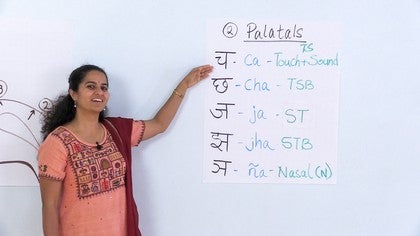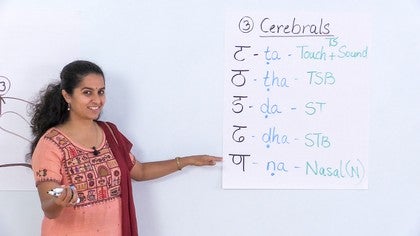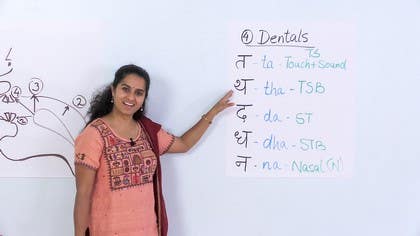Description
About This Video
Transcript
Read Full Transcript
Namaste friends welcome back again we were looking at the consonants and I hope you join me for the guttural which is the first set of sounds that the human vocal instrument can make as consonants we had five sounds at the throat the next set of sounds is there at the palate level so they are the five palletals we saw what they sounded like they were the ch ch ch ch now let's see what they look like the first palatal sound that we have is the ch and it is a combination of and you can often get it clearly if you can put your tongue down behind your lower teeth automatically the tongue will tend to touch the palate behind and you get the sound sure if you want some help you can even do the vowel e so you do the vowel e and then say ch ch there is the element of touch and then the sound uh so ch ch now let's see what it looks like that is the letter chair say that with me and look at it the more you try and picturize the sound the simpler and faster you will learn it so chair in English in the transliterated form it is written with a C and an A you have to remember that this is a transliterated form which corresponds to the the we are trying to get a phonetic link to the sound of the language and therefore it is not a curve but this is a chair the C and A is the chair in terms of the mechanism of the sound it corresponds to the element of touch and sound so it is touch sound and we can represent it to simplify it with a code which is T and S that will be quite handy next we move on to the letter which is a combination of touch and sound accompanied with the breath say that once more lovely now let's see what it looks like that's the ch once more ch in transliteration we add the H to it and you have the ch terms of the mechanism touch sound breath lovely next let's look at the third sound in this set it is the combination of sound and touch this is a little harder to pause in between but you can almost hear the sound and lovely let's see what it looks like now it's a bit the reverse of the chair that is the job and in English in the Roman script it is represented by the J and a in terms of mechanism of sound it is the sound first followed by the touch you're getting a hang of it great let's look at the fourth sound which is the J so it's sound touch breath and this is what it looks like say that in transliteration it is J H a once more which is a combination of sound touch and breath the last letter in the series is the near and it is a combination of the palette with the nasal let's see if you can do that again yeah and this is how it looks yeah say that yeah and then in English or in transliteration it is represented with an n and a small wave on top this is the yeah in terms of the mechanism it's the nasal which will represent with the end yeah that's good so now let's see if you can say that together yeah once more yeah you want to try saying that by yourself let's see super a last time we'll say together yeah great we've done the palatals now let's move on to the cerebrals next







You need to be a subscriber to post a comment.
Please Log In or Create an Account to start your free trial.